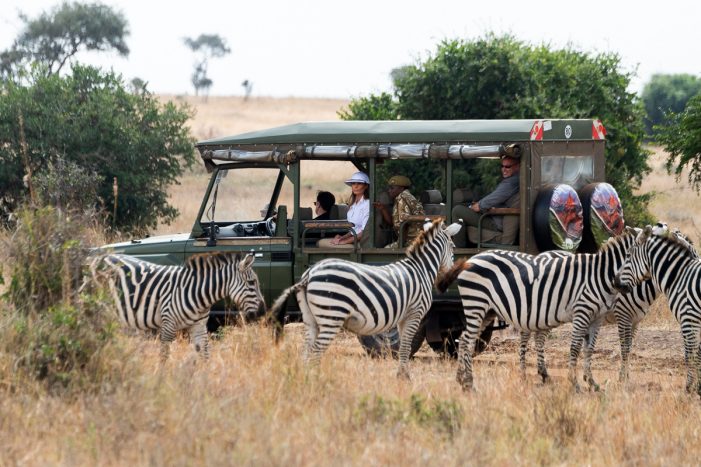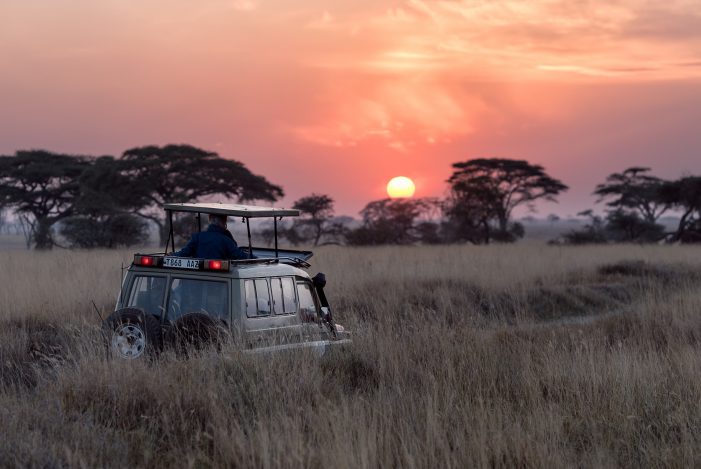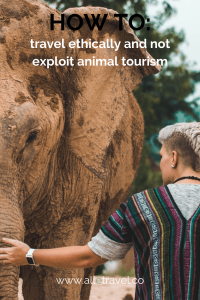Your Guide to Ethical Animal Tourism: How to interact with animals on your trip without being an a*shole
July 10, 2019 | by Riana | Posted in Places, Travel IQ

Whether it’s our dogs and cats at home, or the allure of seeing an Asian elephant or spotting the Big Five in East Africa, we at allé, as well as our clients, love spending time with animals. And the idea of getting up close and personal with animals we’ve only seen pictures of is a bucket list item for many world travelers. But the problem is, sometimes our eagerness to visit a creature we admire so much only ends up hurting the animal itself. How do we make sure our love for animals and desire to interact with them on vacation is ethical? How do we ensure our wildlife experiences are humane and respectful?
How do we engage in animal tourism (without being a*sholes)?
In a nutshell: The goal of ethical animal tourism is to ensure the humane treatment of the animals above all else. The tourism aspect allows visitors to interact with or observe the animals, in order to increase awareness or funds for on-going conservation and protection. Unlike with zoos or circuses, the animals are not kept in small cages or made to do tricks. They are in as close to their natural habitat and community as possible. Visitors can observe or engage with them in safe ways that do not take away from the animal’s welfare.

Your ethical animal tourism cheatsheet:
Engaging in these three activities is never okay and is always incredibly painful and inhumane for the animals in question. Please, don’t do it!
Riding elephants
Many people dream of riding an elephant before they learn that this is actually a very harmful activity for these gentle giants. In order to ride an elephant, the elephant must be tamed, which is a torturous process that starts when the elephant is just a baby and involves beating, starving, sleep deprivation and caging. In addition, the metal chairs placed on the elephant’s back are very painful, especially when they’re being made to give rides to tourists all day long. Instead of riding, you can opt for programs that let you hang out with elephants in a more natural way. Depending on your personal opinion on animal interactions, this may include observing a family of elephants, feeding them bananas or bathing them in a river.
Photos with tigers
Another popular animal encounter, especially in Southeast Asia, is taking photos with tigers. While it might sound cool to get up close and personal with a big cat, it’s not cool at all. Tigers are wild animals. In order to safely allow tourists to take photos with them, tigers are heavily drugged and often declawed. Your Instagram photo just isn’t worth that!
Swimming with dolphins
Like tigers and elephants, dolphins are wild animals too. However, this is easy to forget when we see photos and videos of dolphins giving kisses, high fives and rides to smiling tourists. But dolphins aren’t meant to perform tricks. Interacting with hundreds of visitors every day is exhausting for them and can cause them to act violently (which often means they’ll be put down) or contract diseases. In addition, dolphins kept in captivity are often taken from their families and forced to live in small, shallow pools that don’t allow them to swim freely or stay with their pod. If you want to see dolphins, consider heading out with an experienced boat where you can spot dolphins swimming in the wild.

Do your research
Many wildlife experience operators will say they take part in ethical animal tourism. They will advertise themselves as sanctuaries or rescues. But sadly, not all of these organizations are living up to their names. To decide which organizations truly are treating wildlife respectfully, you’ll have to do a bit of research.
Here are a few things to look at:
- Read reviews. What are your fellow travelers saying about their experience?
- Look at photos, especially from guests. Does it look like the animals have enough space to roam? Do they have access to shade, food and water? Are cages, chains or other devices used to control and contain them?
- What is the history of this organization? How long has it been around for? An organization with a long history has likely had to prove its ethical work.
- How many animals do they care for? Places that are overcrowded aren’t giving the animals the space and care that they need.
- What activities do they offer and what is the schedule like? Check to see if the activities seem unnatural (see below) or the schedule of activities seems too exhausting for the animals.

What to avoid
You want to avoid patronizing any organization that advertises animals doing shows, tricks or rides, or any behavior that is unnatural for that animal. Not sure if a behavior is natural or not? Just ask yourself, “Would this animal do this in the wild?” An elephant playing football or a dolphin giving kisses doesn’t seem like natural behavior for a wild animal.
A big red flag is anything that is used to unnaturally control the animals so that a visitor can get a great photo with them. Remember, these animals aren’t pets.
Look out for warning signs. Here are some big ones you’ll want to avoid:
- Bullhooks being used to control elephants
- Drugs used to sedate tigers
- Feline animals having their claws removed
- Birds having their wings broken so they can’t fly away
- Snakes having their venomous teeth removed
You also want to avoid anything that would unnaturally infringe on an animal’s environment. For example, avoid safari organizations where the vehicles will drive off-road and into an animal’s habitat, just so you can get a better view. The roads are there so that the animals and their habitats can be protected.

Ask yourself: Who is this benefitting?
Is what is being done at this organization for the benefit of the animals or the visitors? If this organization is truly committed to ethical animal tourism, all activities should benefit the animals. For example, if you go on an elephant encounter where the elephants are doing tricks, that’s obviously just to entertain visitors.
All ethical animal tourism should benefit the goal, as laid out by Responsible Travel, “to conserve and preserve these beautiful animals and their close communities in the most effective way possible.” If the organization you’re working with doesn’t put their animals first, then that isn’t the kind of organization you want to be supporting.
Consult reputable lists
It can be overwhelming to figure out which wildlife organizations truly are humane and which ones are not. There are a lot of organizations out there and the research could be endless. Luckily, we can turn to reputable authorities to see which they support.
Check out this list by Responsible Travel to see which elephant sanctuaries get their seal of approval. There’s also this list of approved sanctuaries by WASP (World Animal Sanctuary Protection).

Learn more about the organization
Once you’ve narrowed it down to a few organizations, it’s time to dig a bit further.
What is the purpose of this organization? Do they support endangered species by maintaining a conservation area, rehabilitation, or adopting orphaned animals? Beyond catering to tourism, what is their role in maintaining, promoting and bettering animal welfare?
Is there more to their work? Beyond what you experience as a visitor, what else is this organization doing to meet their mission? Some organizations will work with local government to create protected habitats or to fight against poaching. Other organizations invest in education and awareness raising, or create job opportunities for locals who can work with them.
Will the organization answer your questions? If you’re unsure about any aspect of an organization’s practices, you should be able to ask them and receive a direct answer. Transparency is important. An ethical animal organization should be open to answering any further questions.
And most importantly, is protecting animals the number one goal of this organization? If no, then it’s time to look elsewhere.

It’s okay if you’ve made a mistake
You may be reading this and realizing that you’ve supported an unethical operation before or taken part in an unethical animal encounter. That’s okay. Don’t beat yourself up about mistakes you’ve made on past trips. This is your opportunity to learn, educate others and make better choices on your next trip.
Sadly, a lot of the animal abuse, suffering and mistreatment at unethical organizations is done behind closed doors. Some animals are drugged, trained with fear and violence, or taken away from their mothers at a young age to ensure they’re compliant. These sorts of things are not immediately, or sometimes at all, evident to visitors. These unethical organizations are only able to stay in business by keeping all of these practices a secret.

Doing it right
To engage in ethical animal tourism, your role should be observation of animals in their natural habitat with an experienced company that is working to further protect those animals. If you’re interacting with the wildlife directly, it should be in the most unobtrusive way possible that honors their natural behavior and life in the wild.
At the end of the day, it comes down to respecting the animals. Do your research, ask questions (you can ask your allé travel planner!), and use your best judgment.
The best ways to support ethical animal tourism are with your dollar and your voice. Patronize organizations that are ethical and cruelty-free and then spread the word. This is the best way to stop exploitative and unethical businesses from operating, and to support the amazing work that humane organizations are doing to protect animals.
In fact, many elephant encounter operators in Northern Thailand are now advertising “no riding” thanks to the outcry of visitors who refuse to ride elephants. Because of our commitment to ethical animal tourism, tides are starting to change.
Encountering wild animals can be the most memorable part of a vacation, and learning about their protection can be truly life changing. Just ensure you’re interacting and observing animals the right way.
Pin it for later:












